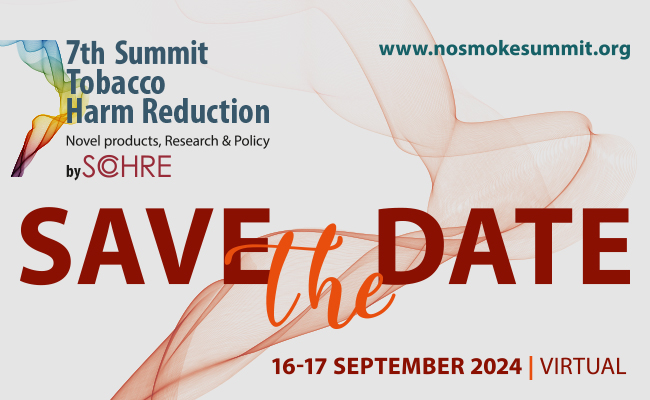Professor Ignatios Ikonomidis, SCOHRE president and president of the Summit’s Organising Committee addressed the audience at the official opening of the 6th Summit.
SCOHRE, the International Association on Smoking Control & Harm Reduction, is comprised by medical doctors as well as specialists in behavioural science and psychology, who join their efforts towards a smoke-free world and better health for all. Although smoking cessation is the “holy grail” for the medical community, Prof. Ikonomidis stressed, where cessation repeatedly fails, switching to less harmful products expected to result in benefits for many smokers should be an option.
After a brief presentation of the well-known effects of smoking on the cardiovascular system, as well as the effects of nicotine on the brain and the nicotine withdrawal symptoms, Prof. Ikonomidis referred to the Fagerström test, a six-item questionnaire that helps assessing dependence on nicotine. He then shared information on the work done at the Smoking Cessation Clinic at Attikon Hospital in Athens, Greece, where multidisciplinary teams comprised by medical doctors, psychologists, and specialists in ergotherapy provide all available tools for smoking cessation: pharmacotherapy (i.e., bupropion, varenicline), NRTs and, lately, e-cigarettes with or without NRTs, as well as behavioural and psychological support.
Studies have showed that, although pharmacotherapy and NRTs are successful at the beginning, as witnessed by a significant improvement in oxidative stress and carbon monoxide (CO) in the first three months, 1-year follow-up shows that only 45% of patients still abstain from smoking and that those (55%) who relapse have worse vascular function.
As for secondary prevention, Prof. Ikonomidis said that only 5% of people who had suffered a heart attack and wanted to stop smoking participated in a smoking-cessation program, although it was offered to all; 6 months later, 65% had relapsed and were still smoking.
Due to the lack of success of pharmacotherapies to achieve complete smoking cessation, harm reduction strategies seem promising. This is very important when data show that, if we eliminate smoking, we may even be able to avoid as much as 90% of all lung cancers, and that, in the EU, 27% of all cancer deaths is linked to smoking.
Prof. Ikonomidis presented two successful examples of harm reduction policies, one in the United Kingdom, where nicotine vaping programs have proved to be safe and more successful compared to NRTs in achieving smoking reduction, and one in Sweden. Swedish men consume the same volume of tobacco as males in the EU, but more than half in the form of snus, while Swedish women consume most of the tobacco from cigarette smoking. Swedish men managed to reduce by nearly 50%, not only cancer, but also ischemic heart disease, stroke and COPD. The US Federal Food and Drug Administration (FDA) has acknowledged Swedish snus as the first, and so far the only, less harmful tobacco product, which poses a lower risk for mouth cancer, heart disease, lung cancer, stroke, emphysema, and chronic bronchitis.
Studies have showed that nicotine itself does not impair the endothelial function; rather, it is the combustion, which provides carbon monoxide and toxicants, that reduces the endothelial and vascular health, Prof Ikonomidis said. A study by his team on the acute and chronic effects of conventional and electronic cigarette smoking showed that electronic cigarette smoking increases arterial stiffness and oxidative stress to a lesser extent than a single conventional cigarette. In 2021, a Cochrane Database meta-analysis showed that, for every 100 people using nicotine e-cigarettes to stop smoking, 9 to 14 might successfully stop, compared with only 6 of 100 people using nicotine-replacement therapy. Vaping poses only a small fraction of the risks of smoking and switching completely from smoking to vaping conveys substantial health benefits over continued smoking; it should be noted, however, that this does not mean e-cigarettes are safe. Practitioners and health professionals specialized in smoking cessation should provide behavioral support to smokers who want to use an e-cigarette to help them quit smoking.
A novel type of products, the heat-not-burn tobacco (HNBC) products, where tobacco is heated and not burned, also shows promising results, with reduced oxidative stress and platelet activation, linked to reduced CO exposure. The FDA authorized these tobacco heating systems as products with “reduced exposure” to toxicants.
Prof. Ikonomidis concluded that harm reduction is already happening, and smokers have the option to choose products according to their similarity with cigarettes. The final battle for harm reduction (HR) is not so much on how safe the HR products are, but if nicotine can be eradicated or will be accepted. Novel smoking products show a smaller emission of toxic substances compared to conventional cigarettes and, although smoking cessation is the primary goal of the medical community, alternative solutions can be used to reduce the detrimental consequences of cigarette smoking, when several efforts for smoking cessation have failed.
In previous Summits it has been established that, although the prevalence of smoking has decreased steadily around the globe, the total number of smokers has increased, as populations have grown. There is an increasing interest on Tobacco Harm Reduction, but more data is needed for politicians and public health regulators to make informed decisions. Consequently, the objective of the 6th Summit is to offer opportunities for scientists of different countries to present, discuss, and challenge recent data, but also to provide an environment where regulatory authorities and policy makers may interact with the scientific and medical communities on the prospective course of action For a Smoke-Free World.
Prof. Anastasia Barbouni welcomed the fact that the 6th Summit gives the opportunity to establish a new dialogue on harm reduction on an international, EU, and national level. Prof. Giuseppe Biondi Zoccai said emphatically that we could wait for 20-30 years to make the best decisions, or we can make the best guess now and leverage the new technologies in an informed fashion in order to minimize patient risks. Finally, Dr Fares Mili stressed that smoking begins as a habit and finishes as a real addiction and that motivation only is not enough to quit smoking. Therefore, harm reduction tools are very helpful, and are a burning issue especially in Asia, where smoking prevalence is still very high.









